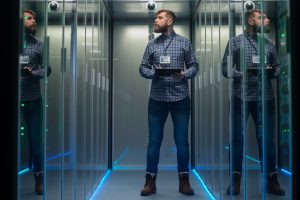This audio was created using Microsoft Azure Speech Services
Schneider Electric was showing a couple of new products at the recent 2014 AHR Expo in New York, including new versions of its Uniflair HDCV large capacity chilled water units and its next-generation InRow RC Chilled Water Cooling unit.
At the event I caught up with Joe Capes, Business Development Director for Schneider Electric’s Cooling Line of Business, and we shot some video (above) where he explains the key enhancements to and benefits of each of the products.
First, the company introduced two new Uniflair HDCV large capacity chilled water products, the HDCV 4500 and HDCV 5000. Both are intended for large data centers – primarily cloud and colocation facilities that are looking for higher capacity in terms of performance and heat rejection along with redundancy.
The 4500 has the same dimensions and footprint as the company’s previous 4300 model but delivers higher capacity while drawing less power. That’s achieved partly through the design of the coil system as a whole, but also by mounting fans below the raised floor underneath the units, Capes says.
The new units also feature dual power inputs for redundancy, with a built-in automatic transfer switch. “That gives customers the ability to feed two independent power supplies to the unit for redundancy and recovery,” he says.
There’s also an optional capacitor that provides power ride-through to the controller in the system. “If you have a power outage, the system will return to full capacity much quicker because the controller stays powered,” Capes says.
The new InRow RC chilled water unit is based on the same 300mm-wide cabinet design that the company launched in 2006 but features improvements in efficiency. It comes with an optional high-temperature chilled water version that allows it to integrate with chillers that provide higher supply water temps, up to 59 degrees F.
“That’s good for customers that are using water-side economizers for free cooling,” Capes says. “You’re talking about savings not only from the efficiency of the indoor cooling unit but also efficiency from the outdoor chiller plant. In many data centers, the chiller plant can represent 30% to 35% of the total energy consumed by the facility so it’s a really significant part of the overall infrastructure to address.”
Asked what other topics were hot at the event, Capes didn’t hesitate: data center infrastructure management, or DCIM.
“We find a lot of customers are really driving toward the next phase of efficiency, which is how do you manage, control and operate your facility,” he says. “Schneider Electric is one of the few vendors at the show that has the ability to combine total operational and facility management and control through our DCIM platform called StruxureWare.”
Indeed, at the event the company was demonstrating StruxureWare modules including EcoStream, which is essentially computational fluid dynamics (CFD) software that enables customers to conduct data center modeling to ensure proper air flow, layouts and the like.
The company was also showing its EcoBreeze indirect evaporative cooling unit, which now has two economizer modes.



